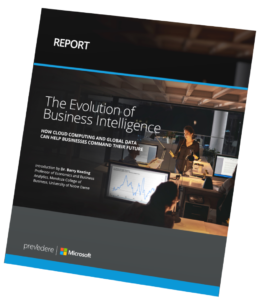Last Updated: June 22, 2018
According to Gartner, 70%-80% of corporate business intelligence projects fail to deliver the insights executives need. This, in turn, leads to uncertainty in the C-suite, as only one-third of CEOs trust the accuracy of their internal analytics according to KPMG. In the new Evolution of Business Intelligence report, Prevedere has partnered with Microsoft and Dr. Barry Keating, professor of economics and business analytics at the University of Notre Dame, to describe the critical turning point currently facing traditional analytics. Read the full report here >>
When business leaders lack confidence in their data, decision-making based on that data becomes problematic, especially when it comes to future planning and forecasting. In today’s fast-paced, technology-driven world where business moves at the speed of data, executives must have accurate and reliable analytics and business intelligence tools.
Top Business Intelligence Mistakes to Avoid
Prevedere recently worked with Microsoft and Dr. Barry Keating, professor of economics and business analytics at the University of Notre Dame, to discuss some of the top business intelligence challenges many executives face and how the merging of technology and data will help business leaders make smarter, faster, forward-looking decisions. Below are some of the top business intelligence mistakes from the resulting report, The Evolution of Business Intelligence:
- Failing to Embrace External Data

Many business leaders tend to rely solely on historical internal data to forecast and make operational decisions. While this information is important, forecasting on this data alone is an outdated tactic and does not provide a holistic view of what truly drives businesses. Companies incorporating external data into planning and forecasting projects will discover patterns impacting operations that have been previously hidden and unknown. This allows not only for more accurate predictions but also provides information faster and with more insight into the underlying reasons behind forecasts.
- Absence of Business Support
Executives and managers who understand and recognize the value of accurate forecasts are just as important as the technology and data providing the insights. However, a lack of business support can quickly derail any business intelligence initiative. Many business leaders often cite the cost, resources and time needed when objecting to business intelligence implementation. It is important for the genesis of these initiatives to be rooted in a company-wide analytics strategy. Any business intelligence project for a core group of users or a specific business unit should be put on hold until a plan to achieve company-wide benefit is accomplished.
- Wasted Time on Ad-Hoc Requests versus Predictive Insights
Data teams are overwhelmed by a barrage of ad hoc data requests, starting a cycle where organizations simply do not have enough time or resources to tackle the questions and problems executives need answers in real-time. In fact, according to PwC, only 20% of work done by most analytics teams is focused on insights detailing future performance indicators; meaning 80% of an analytics team’s time is spent on work that cannot be leveraged for additional requests.
- Not Emphasizing Data Integrity
The quality of business intelligence insights is directly associated with the quality of data that is fed into the system. If the system uses poor data, the business insights, even if well-presented, will not be able to directly answer the challenging questions executives face every day. This is one key reason enterprises should invest in technology since as much 80% of a data scientist’s time is wasted on data preparation. Improved data quality, paired with economic external data, will produce timely and accurate insights, thus improving trust between the C-suite and data teams.
 Companies intelligently investing in tools that leverage machine learning to augment existing BI investments and processes take the guesswork out of forecasting and gain actionable intelligence that produces results. For a more in-depth look at how to avoid the top business intelligence mistakes, and accurately turn data into decisions, download our complimentary whitepaper “The Evolution of Business Intelligence.”
Companies intelligently investing in tools that leverage machine learning to augment existing BI investments and processes take the guesswork out of forecasting and gain actionable intelligence that produces results. For a more in-depth look at how to avoid the top business intelligence mistakes, and accurately turn data into decisions, download our complimentary whitepaper “The Evolution of Business Intelligence.”